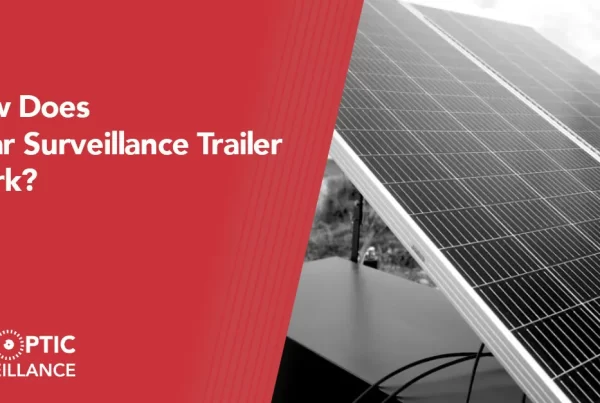Video Surveillance System for Your Business
Find an answer to all your questions about purchasing a video surveillance system for your business.
When making a video surveillance system purchase, consider the following information.
- Your business may be safeguarded by video surveillance against theft, incursion, fire, flood, and burglary.
- Consider the sorts of cameras you want, the storage you want, and the locations of your organization that require security before evaluating solutions.
- Internet Protocol and analog security cameras are the two most common varieties.
- This article is for small company owners who are thinking about investing in a video surveillance system and want to know what kind of system to buy and how much to budget.
Every business has to be safe. In the end, how can you be successful if you can’t safeguard your assets? With cameras that offer computer-like features like motion sensors, remote viewing, and smartphone alerts, video surveillance systems are more sophisticated and efficient than ever. By pressing a button, some devices even instantaneously call law enforcement.
More effective techniques of recording and storing data have also been made possible by technological advancement. Small company owners have inexpensive access to extremely strong surveillance equipment. Read on for our buyer’s guide to video surveillance systems if you’re in the market for one but aren’t sure where to begin.


Commercial security cameras for business
- Business security cameras with enhanced coverage and IR that improve situational awareness
- Video analytics with AI to find incidents
- Hours of video are easily sorted through by Video Search to locate a suspicious person or vehicle.
- Integrates with third-party ONVIF® compliant platforms
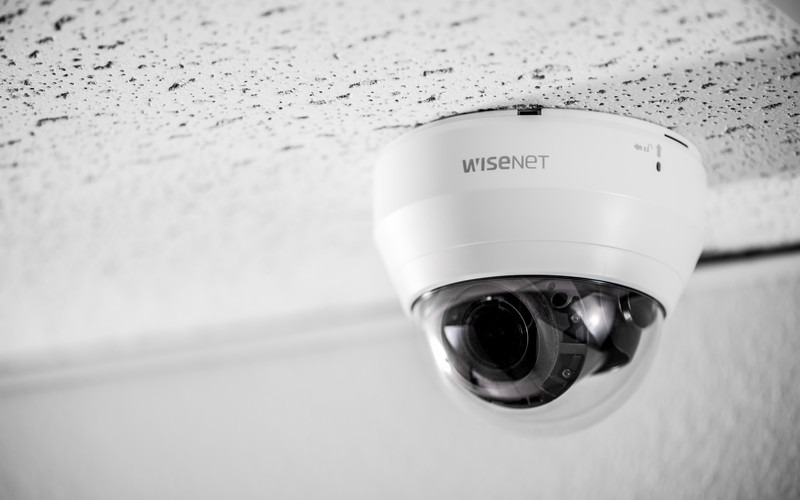
Things to consider when buying a video surveillance system
When choosing a video surveillance system for your company, you need take into account a number of variables.
Installation
You may install your own surveillance system if your company is tiny and you don’t need to monitor a lot of space or set up many cameras. Bigger companies with several sites and complex installations want to hire a specialist to perform the installation.
Pricing
The number of cameras you need, the size of your company, the type of storage you want, the length of time you want to keep videos, and the features you want, such as video analytics or motion detection, all affect pricing. In general, monthly costs for basic one- or two-camera systems start at approximately $50, while complex systems with multiple cameras can cost up to $5,000.
Type of camera
Internet Protocol (IP) and analog cameras are the two primary categories of cameras used in video surveillance systems. The use of IP cameras, which provide additional features and capabilities, is replacing older analog cameras in some applications. Networked IP cameras may perform additional services including video analytics, automated warnings, and better definition picture capturing.
Type of storage
With your video surveillance system, you have three options for video data storage: NVR, DVR, and hybrid. Analog cameras are used by DVRs, which stand for “digital video recorders.” Network video recorders, or NVRs, are used with IP cameras. You may mix analog and IP cameras using hybrid systems.
Amount of storage
Your surveillance system’s storage requirements are determined by the required quality and the length of your films. You must provide your machine a lot of storage capacity if you intend to record and save high-quality video. Choose whether you’ll keep the video locally on the camera’s internal storage drive, externally on a hard disk, or online on a cloud-based service.
Custom Design
The majority of providers offer a high level of customization, so you can quickly adapt a system to the demands of your company. There is a solution for everyone, whether you require a comprehensive system to monitor several places or a few cameras to monitor your shop.
Features
Video surveillance systems may be equipped with a wide range of functions, including as night vision, intelligent motion detection, and pan, tilt, and zoom (PTZ). Determine the characteristics your company need, then choose the cameras and surveillance system accordingly. For instance, if you primarily require a system to watch your business at night, get one with good night vision and constant notifications.
Areas of business that need protection
The type(s) of camera(s) you require depends depend on where you intend to deploy your surveillance. For instance, you’ll likely want a weatherproof exterior camera with PTZ capabilities and motion alerts if you need to keep an eye on your back door.
Cloud Based Access Control
Learn about cloud based access control system and its futures.
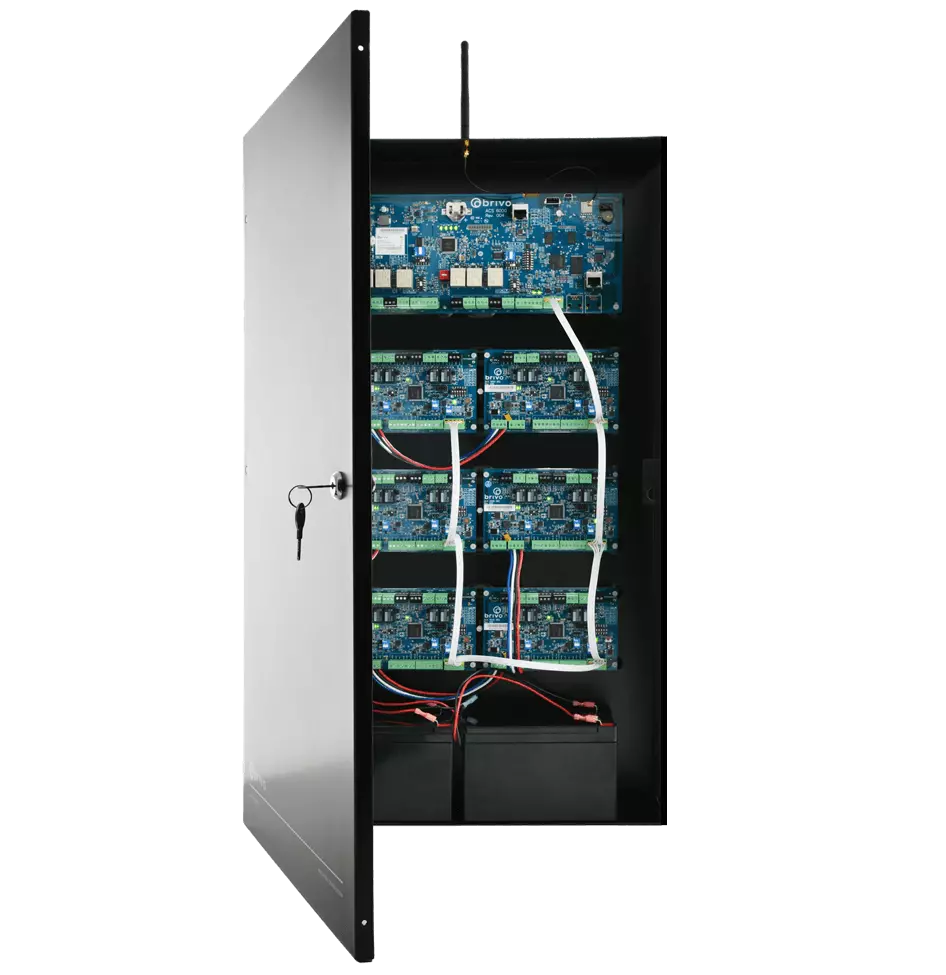
Top video surveillance system providers
Houston Security Solutions, which we ranked as the best overall video surveillance system in Houston, has a wide range of features that make it a versatile choice for any business. Our system offers 24/7 professional monitoring from its agents, while also allowing you to watch over the system yourself. It also provides a wide selection of storage devices for your system.
For businesses on a budget, Houston Security Solutions is a competitively priced security system with a user-friendly interface. We offer both local and cloud storage options, and it integrates with Access Control and other products and platforms.
Benefits of a surveillance system
In addition to helping law enforcement rapidly apprehend any would-be burglars, security camera systems may help staff be more accountable, help you track productivity, and even perhaps lower your insurance prices. Although while having a video surveillance system might appear expensive up front, the benefits over time and the peace of mind may make the investment worthwhile.
Access Your Office with Smartphone
Discover why thousands of companies have Access Control System
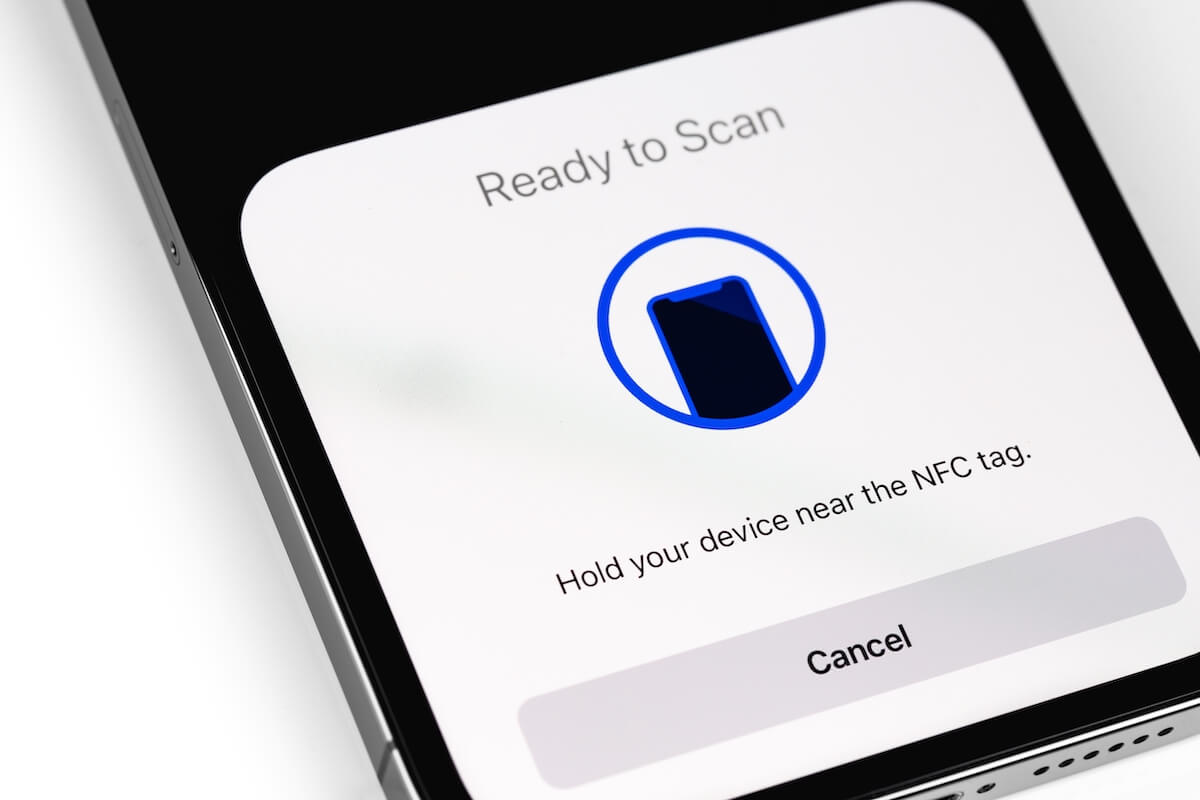
IP cameras vs. analog cameras
The distinctions between these two categories of security cameras are shown below.
Resolution
Compared to analog cameras, IP cameras are more powerful and often capture images with a resolution of 1 to 5 megapixels. As compared to the 0.5 megapixel analog footage, which is grainier, it results in very clear image quality. In general, IP cameras have a wider field of view than analog cameras.
Video analytics
Analog cameras do not have extra functionality that IP cameras do. One such is video analytics, which enables automated recording and mobile notifications when motion is detected in the camera’s area of view. While your business is closed and people are moving around the property, this is very helpful. You may set up the system to highlight incidents like this and send notifications and video of the incident straight to your smartphone. A direct, one-touch link to local police enforcement is also provided by certain systems.
Network video recorders
NVRs, which have a number of advantages over earlier digital video recorders, are compatible with IP cameras and offer additional advantages. Here, we’ll go into greater depth about those. In summary, NVR records video of a higher quality and makes it more simpler to scale up systems than DVR can.
Power over Ethernet (PoE) switches
IP cameras include a feature called PoE switches that both transmit data from the camera and give it power. The setup is more complicated and there are more cables with analog cameras since they need a switch to run the camera’s signal and a separate power supply. Moreover, PoE switches are typically thought of as a more secure method of data transmission.
Comparable system cost
Although IP cameras are often more expensive than their analog equivalents, the overall cost of an IP system is typically less than that of an analog system of similar size. An IP system may frequently function with fewer cameras than an analog system since IP cameras also offer a broader field of view.
DVRs vs. NVRs
A central video recorder is necessary for a system’s security cameras in order to broadcast and store the material they are recording. While NVRs are the next development in video recording technology, DVRs are an advancement of the earlier VCR types.
Below is a comparison of DVRs and NVRs.
Resolution of recordings
D1 resolution, the conventional video quality used in closed-circuit television systems, is often provided by DVRs. D1 corresponds to a resolution of 720 x 480 pixels, which is regarded as the industry standard.
But, NVRs may record in high quality (1080p). Over a DVR system, NVRs provide a considerable boost in video quality. For the sake of comparison, 1920 x 1080 pixels is the equivalent resolution for 1080p. Hence, the image is significantly clearer.
Camera connections
A BNC cable from the DVR is plugged into the camera to connect analog cameras to a DVR system. Additional wires are needed to connect the DVR system to more cameras. DVR systems are challenging to scale up since you must buy a brand-new DVR before adding a new camera to the system once every BNC connection has been used up by a camera. The distance between the linked cameras and the recorder is also a need for DVRs; otherwise, video quality suffers.
These issues are resolved by the NVR because it is immediately connected to a network. The NVR may then receive video from IP cameras that are linked to the same network, normally using a PoE switch. Because NVR systems may accept a new camera once it is installed to the network, they are significantly simpler to scale up than DVR systems. The bare minimum that would be needed is an extra PoE switch.
Some IP cameras are also wireless and use Wi-Fi to send video to the NVR. As long as a camera is linked to the same network as the NVR, there are no distance restrictions. Nevertheless, the biggest drawback of an NVR system is that not all IP cameras are compatible with all NVRs. When purchasing your cameras, make sure they are compatible with the particular video recorder.
Hybrid video recorders
Video surveillance systems called hybrid video recorders (HVR) use both IP cameras and analog cameras. HVR systems are popular because of their adaptability; for example, if you’re upgrading an old system but don’t want to get rid of your old analog cameras, an HVR can help you make the transition and get ready for a full IP system in the future.
Join UPS Stores Using Access Control
With Cloud Based Access Control, UPS Stores can regulate and track who enters its facility for PO Boxes.
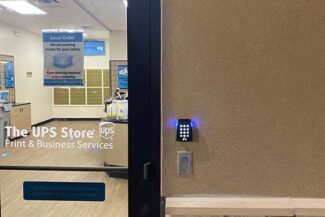
What to look for when choosing a camera
Resolution
When choosing a camera, this is one of the most crucial factors to take into account. You need an IP camera if you wish to capture photos in high resolution at least in 720p. Don’t skimp on this step if you want to make sure that your camera will capture a distinct, legible image.
Frame rate
This is also another crucial feature of a camera: the smoother the footage, the higher the frame rate. A motion picture is created by stitching together a number of still photos into a video. The less often a picture is captured, the choppier the video will be at lower frame rates. Real time is commonly measured in terms of 30 frames per second.
Models
Security cameras come in a variety of forms. The most popular types are PTZ cameras, which allow for remote control of the field of view, dome cameras, which are frequently affixed to ceilings, and bullet cameras, which are the rectangular boxes you may see emerging from walls. Take into account which sorts of cameras will provide you the kind of video you want with your system based on your security requirements and the location where you want to put the cameras.
Indoor/outdoor
Some security cameras are designed only for indoor use, thus they won’t withstand Mother Nature as well as their outside counterparts. Get waterproof cameras if you want to use them outside. Otherwise, moisture or dirt will obstruct the clarity of your video feeds or, worse, could break the camera.
Lighting
Many security cameras use low-light infrared (IR) photography, which enables them to record quality video even when it is dark outside. A camera’s ability to capture clear, detailed footage at night improves with the number of IR LEDs it contains. Make sure your camera has enough of IR LEDs if recording video in the dark is important.
Audio
While some cameras hardly pick up any audio, others do. Some even include two-way audio capabilities, allowing a viewer on the other end to speak with someone in the camera’s field of view.
What to look for in a video recorder system
Storage capacity
The number of cameras in your system, the resolution of each camera, the amount of archived material you wish to retain, and how long you expect to preserve recorded footage all affect how much storage you require. If more than one camera is filming at a higher resolution, the video will soon fill up your storage. When you reach the system’s capacity, you may configure a video recorder to replace the oldest film. Nevertheless, if you’re not careful, the system can delete stored material that you still need.
You may use internet calculators to determine how much storage space you’ll require based on the specifics of your system. For instance, a four-camera system employing IP cameras with a 24-hour operation, each with a 2-megapixel resolution and a 5-frame-per-second frame rate, and video compressed into MJPEG files on an NVR, would need 2.79TB of storage capacity for video. For a fairly large system, there is a lot of data, so figure out what type of capacity you’ll truly require and make your plans appropriately. Save a little extra space aside from the estimated amount so you may save any really noteworthy video you might require later.
Cloud storage
In addition to storing it on your video recorder, you may also store recorded video on the cloud. This has a few clear benefits, like greater storage capacity and remote access to your recordings. By storing your films in the cloud, you can continue to watch them even if your hardware is lost, stolen, or tampered with. Be sure that this won’t clog up all of your network’s bandwidth and slow it down, though. It is recommended to plan uploads to the cloud or upload them after busy business hours in order to make the most effective use of cloud storage.
Several cloud storage options require a monthly subscription price, especially if you wish to keep your video recordings forever. Ask the storage provider what cybersecurity measures it uses to secure your data to ensure you’re getting the most for your money.
Camera compatibility
Not every camera is compatible with every video recorder. Although IP cameras are used by NVRs and analog cameras by DVRs, the compatibility issue goes beyond these differences. For instance, certain NVR systems only work with IP cameras made by specific companies. A video recorder’s compatibility with the cameras you’ve bought should be considered before purchasing. The cameras need to be able to provide you with the information you require if you’re working with a surveillance system integrator to setup your system.
Compression
Compression reduces the amount of data that is delivered to your video recorder, freeing up space. MJPEG and H.264 are two of the most popular high-definition video compression methods. MPEG4 is another option, although the quality is typically worse. The uses of compression techniques vary depending on the technology and your demands.
PoE switches
These exclude other parts that would be required for a DVR system, such as extra power sources and the BNC cables used to link cameras to the DVR, but they only pertain to NVR systems. Instead, a PoE switch that is connected to your network serves as both a power supply and a channel for data transmission to your NVR. The amount of cameras on your system should be your first concern when selecting the type of PoE switch to purchase. How likely you are to scale up in the future is the next factor to take into account.
A few PoE ports are incorporated into certain NVRs, but not all of them. The smallest PoE switches start at approximately $40 to $50 and have roughly five ports. One camera’s data link and power supply are represented by each connector. Some PoE switches have up to 48 different ports, making them ideal if you intend to expand out and install a very big system.
There are also wireless IP cameras that only need to be mounted, but such connections might not be as secure as connected ones. If you use wireless, you must ensure that the signal is difficult to eavesdrop on. Again, it all depends on your individual requirements and the kind of system you’re attempting to build.
Pros and cons of video surveillance systems
Learn the advantages and disadvantages of implementing a video surveillance system at your company.
| Pros | Cons |
|---|---|
| Security is provided by the system for both your workers and clients. | Employees could feel uncomfortable with video surveillance. |
| Workplace crime is decreased via surveillance. | Employees and security personnel may become less alert due to a false sense of security brought on by workplace monitoring. |
| A surveillance system can keep track on employee conduct and stop violence and harassment in the workplace. | It may be expensive to buy, install, and maintain a video surveillance system. |
| If workers are aware that someone is observing, they often have a superior work ethic. | Employees may experience burnout at work as a result of feeling as though they aren’t producing enough due to the increased scrutiny. |
Video surveillance laws
Businesses investing in surveillance systems should learn about and be familiar with the regulations in their jurisdiction. There are particular regulations governing the use of video surveillance in enterprises in sixteen states. In places where a person does not have a reasonable expectation of privacy, such as an office or a sales floor, corporations are often permitted to film individuals. Companies are not allowed to film in areas like bathrooms or changing rooms where a person has a justifiable need for privacy.
Video surveillance system FAQs
The following inquiries concerning video surveillance systems are frequently raised by company owners:
Do business security cameras require contracts?
Contracts are necessary for certain video surveillance services, but not all. When making a purchase, consider this consideration, especially if you want to move your company’s location within the following year or if you don’t want to be bound by a contract.
How often are security cameras monitored?
Also, this is based on your subscription package and the provider. Professional 24/7 monitoring is offered by certain companies as part of your subscription, while it is offered by others either for an additional fee or not at all.
What are the pros and cons of security cameras?
Your level of security may be greatly increased by installing security cameras to guard your company from burglary, theft, infiltration, fire, and other hazards. Depending on the requirements of your company, they may be pricey, but in general they are a good investment.
How long does footage stay on security cameras?
If you want a long-term backup copy of your data, you may pay for long-term or even limitless storage, depending on your provider, or utilize external storage devices. During 14 or 30 days, many surveillance systems save their recordings.





